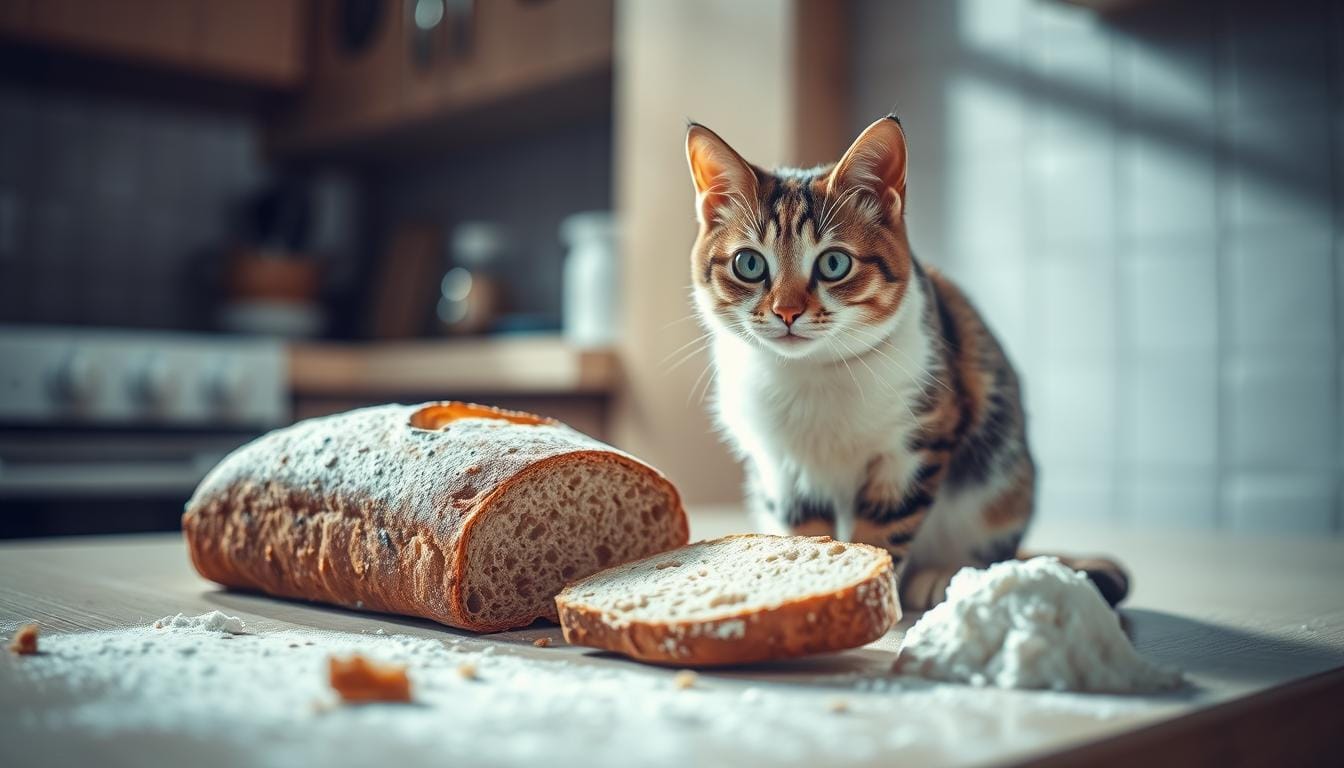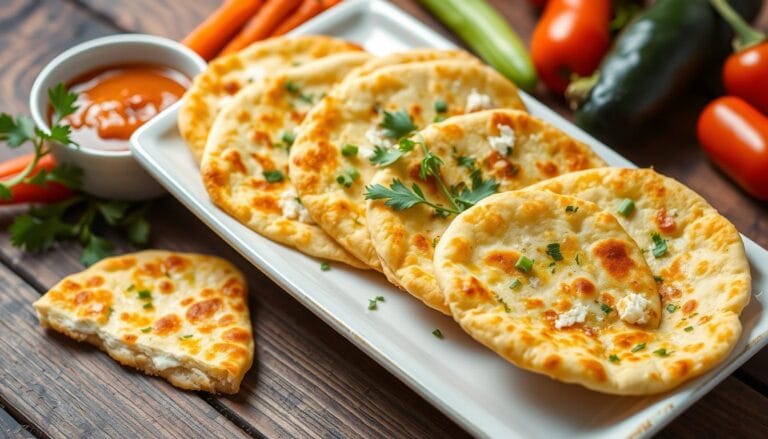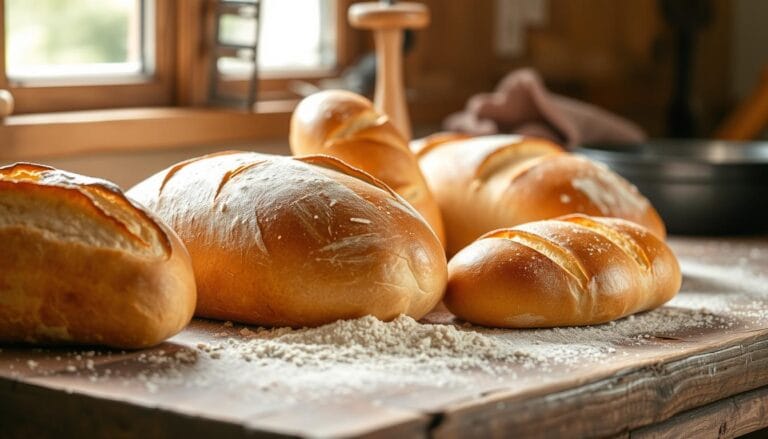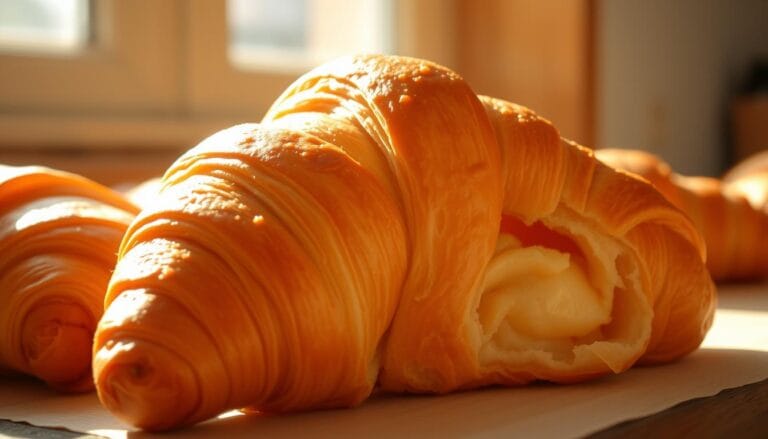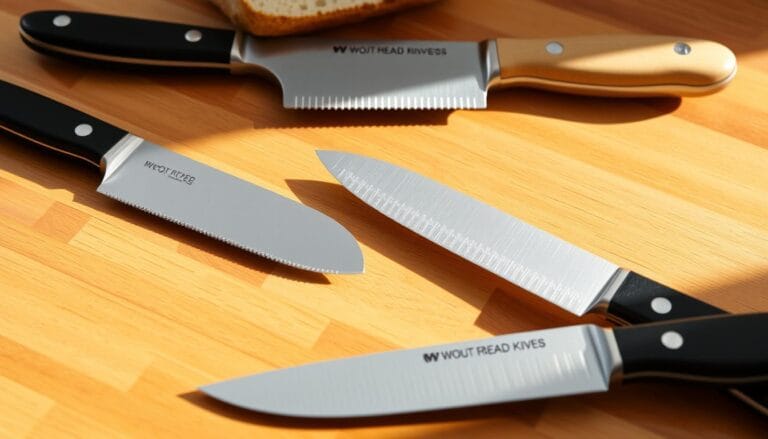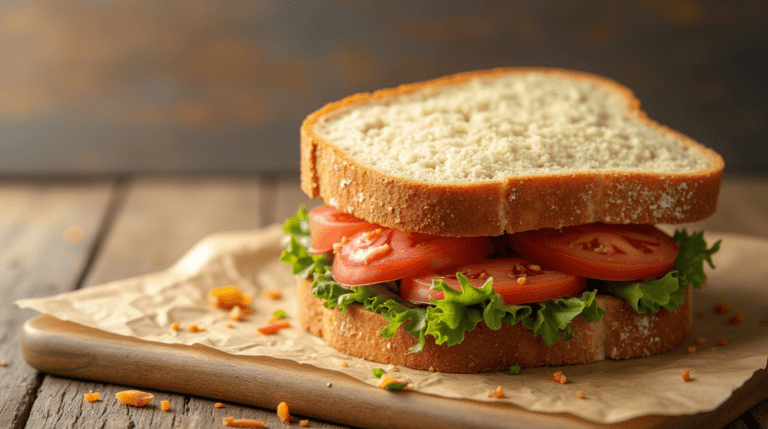Can Cats Eat Bread? The Shocking Truth Revealed!
Can cats eat bread? I’ve watched my cat sniff and paw at bread, making me wonder if it’s safe. Knowing if cats can eat bread is key for their health and safety.
Feline nutrition is complex, and not all human foods are good for cats. Bread is not a simple yes or no answer. It depends on ingredients, how much, and your cat’s health.
Small amounts of plain bread are usually safe, but it shouldn’t be a big part of their diet. Vets say cats can have a little bread, but it’s not very nutritious. Cats are meant to eat meat, not carbs like bread.
It’s all about being careful and knowing the risks and benefits. This helps you make the best choices for your cat’s diet and keeps them healthy and happy.
Table of Contents
Can Cats Eat Bread?? Safety and Risks
Bread can be a tricky topic for cat owners when it comes to pet food safety. Cats can eat a little bit of bread, but it’s not good for them to eat it all the time. Cats need a diet rich in protein, and bread doesn’t have enough of that.
It’s important to know the risks of giving bread to cats. Plain, wheat-based bread is usually okay in small amounts. But, there are a few things to remember.
- Bread doesn’t give cats any nutritional value
- Bigger pieces of bread can be a choking hazard
- Raw bread dough is very dangerous
“Small amounts of bread won’t harm your cat, but it should never replace proper nutrition.”
Raw bread dough is very dangerous for cats. The yeast in it can make your cat’s stomach expand. This can cause:
- Severe bloating
- Respiratory distress
- Potential seizures
Cats with health issues like diabetes or obesity should avoid bread. It has too many carbs and can harm their health. Experts say it’s best to not give bread as a treat.
If your cat eats bread by accident, watch them closely. A little bit is
Understanding Cats’ Dietary Needs
Cats have special dietary needs that are different from other pets. They are fascinating creatures with a unique nutritional profile. This requires careful attention.
Cats are obligate carnivores. This means their bodies need a meat-based diet. Their dietary needs are unlike humans or dogs, focusing on protein and animal nutrients.
Natural Carnivorous Diet
Your cat’s diet is based on their ancestors. Their bodies are made to process animal proteins well. Their digestive system is designed to get the most nutrition from meat.
- Protein is the primary nutritional requirement
- Animal tissues provide essential amino acids
- Meat-based diet supports muscle maintenance
Essential Nutrients for Cats
Cats need specific nutrients for their health. These include high-quality proteins, taurine, vitamins A and B, and minerals like calcium and phosphorus.
“A balanced diet is the cornerstone of feline health and longevity.” – Veterinary Nutrition Experts
Role of Carbohydrates in Feline Diet
Carbohydrates are not key in a cat’s diet. While cats can handle some carbs, they’re not built for large amounts. Bread and other carbs should be treats, not main foods.
Knowing these nutritional basics helps you choose the best diet for your cat. This ensures they live a healthy, vibrant life.
usually okay, but too much can upset their stomach.
Nutritional Content of Different Types of Bread
Knowing what’s in bread helps cat owners choose better for their pets. Bread doesn’t match what cats need to eat. Cats need lots of animal protein because they are meat-eaters.
White Bread vs. Whole Grain
White and whole grain breads don’t offer much good for cats. They are empty calories for cats.
- White bread: Minimal nutritional benefits
- Whole grain bread: Slightly more fiber, but still not recommended
- Cats require less than 2% carbohydrates in their diet
Calories and Carbohydrates
Bread has a lot of calories for cats. A small piece can add too many carbs, causing weight gain.
| Bread Type | Calories per Slice | Carbohydrate Content |
|---|---|---|
| White Bread | 70-80 calories | 15g |
| Whole Wheat Bread | 80-90 calories | 12-14g |
Vitamin and Mineral Content
Cats get what they need from meat, not bread. Bread has very little vitamins and minerals for cats.
“Cats are designed to metabolize protein, not carbohydrates.” – Veterinary Nutrition Expert
Key takeaway: Bread offers no substantial nutritional benefit for cats and should be considered an occasional, minimal treat.
Potential Health Risks of Feeding Bread to Cats
Feeding bread to cats can harm their health. Even small amounts can cause big problems. Regular bread eating can mess with their digestion and nutrition.
Cats need meat to stay healthy, not bread. They are designed to eat proteins from meat, not carbs from bread.
“Cats should not derive more than 10% of their daily caloric intake from human food” – ASPCA Nutrition Guidelines
Feeding bread to cats can lead to:
- Obesity from too many carbs
- Stomach problems
- Nutritional imbalances
- Yeast-related issues
Bread is hard for cats to digest. Its carbs can upset their stomachs. This can cause:
- Stomach pain
- Weight gain
- Less efficient metabolism
Experts say bread is not good for cats. They need protein-rich, low-carb food to stay healthy.
| Bread Type | Risk Level | Potential Complications |
|---|---|---|
| Raw Yeast Bread | High | Stomach expansion, potential poisoning |
| Baked White Bread | Low | Minor digestive issues |
| Whole Grain Bread | Medium | Potential weight gain |
Always think about your cat’s health first. Talk to a vet before giving them human food.
Safe and Unsafe Bread Ingredients for Cats
Knowing what’s in bread is key for keeping your cat safe. Some parts of bread can be very bad for cats.
Not all bread is safe for cats. Some parts are very dangerous, while others are okay.
Toxic Ingredients to Avoid
- Garlic and onions: Highly toxic to cats
- Raisins: Can cause severe kidney damage
- Chocolate: Potentially life-threatening
- Chives: Dangerous for feline health
Acceptable Bread Components
Plain white bread is mostly safe for cats in small amounts. But, it should never be their main food.
| Bread Type | Safety Level | Notes |
|---|---|---|
| Plain White Bread | Safest Option | Minimal risks, occasional treat |
| Whole Wheat Bread | Moderate Caution | More complex ingredients |
| Sweetened Breads | High Risk | Avoid completely |
Warning Signs of Adverse Reactions
Look out for signs like:
- Vomiting
- Diarrhea
- Skin irritations
- Abdominal discomfort
“Cats are obligate carnivores and have no nutritional requirement for bread in their diet.” – Veterinary Nutrition Experts
Remember, bread can have different ingredients. Always talk to your vet before giving your cat human food.
How Much Bread Can Cats Safely Consume

Understanding how much bread is safe for cats is key to pet food safety. Cats need more protein than carbs. One slice of bread has calories that are a fifth of what a cat needs daily.
Vets give clear rules for cats eating bread:
- Portion size: No larger than a thumbnail
- Frequency: Once or twice weekly maximum
- Calorie contribution: Should not exceed 10% of daily intake
“Bread is essentially empty calories for cats, providing minimal nutritional value,” says veterinary nutritionist Dr. Emily Roberts.
Different bread types have varying safety levels for feline consumption:
- Wheat bread: Generally safe in small amounts
- Cornbread: Acceptable in moderation
- Sourdough: Potentially dangerous due to high yeast content
Cats need a lot of protein. Bread should never be a substitute for their regular food. If you give bread, watch for signs of upset stomach or changes in behavior.
Warning: Raw dough is extremely dangerous and can cause severe health complications. Always consult with your veterinarian before introducing any new food to your cat’s diet.
Signs Your Cat May Have Eaten Too Much Bread
Cats are meat-eaters with sensitive stomachs. Eating bread can upset their digestion. It’s important to know the signs of too much bread to keep your cat healthy.
There are several signs to watch for if your cat has eaten too much bread.
Digestive Distress Signals
Look out for these signs of digestive trouble from bread:
- Persistent vomiting
- Diarrhea or unusual stool consistency
- Abdominal bloating or discomfort
- Reduced appetite
- Lethargy or decreased activity levels
Behavioral Changes to Watch
Some behaviors can hint at digestive issues:
- Excessive grooming
- Hiding more than usual
- Vocalization indicating pain
- Reluctance to move or play
When Veterinary Intervention Is Necessary
Call your vet right away if you see:
- Symptoms lasting more than 24 hours
- Severe vomiting or diarrhea
- Signs of dehydration
- Blood in stool or vomit
- Significant changes in behavior or energy levels
“Early detection and prompt veterinary care can prevent potential complications from bread consumption.” – Veterinary Nutrition Experts
Prevention is better than cure. Keep bread intake low and feed a protein-rich diet for your cat’s health.
Alternatives to Bread for Cat Treats

When looking into human food for cats, it’s key to know their special needs. Cats are meat-eaters with needs that are very different from ours.
Instead of bread, try these healthy and safe options that cats love:
- Cooked lean proteins:
- Chicken breast
- Turkey
- Fish (salmon, tuna)
- Protein-rich treats:
- Cooked eggs
- Commercial cat treats
- Small pieces of organ meats
Veterinarians say treats should be no more than 10% of your cat’s daily calories.
“Your cat’s health is directly linked to the quality of nutrition you provide.” – Feline Nutrition Experts
Some more safe choices include:
- Pumpkin (for fiber)
- Small amounts of cucumber
- Tiny carrot pieces
Always start with small amounts of new foods and watch for any bad reactions. Remember, every cat is different. What’s good for one might not be for another.
Common Myths About Cats and Bread
Many pet owners believe wrong things about what cats can eat. It’s important to know about pet food safety to keep your cat healthy. This helps avoid bad food choices.
Here are some common myths about cats and bread that might confuse you:
- Myth: Cats need bread as a regular part of their diet
- Myth: All human foods are safe for cats to consume
- Myth: Bread provides essential nutrients for felines
The truth about cats and bread is not simple. Cats are meant to eat meat, not bread. They can’t digest carbs well.
“Cats require a diet primarily composed of meat, not grains or bread products.” – Veterinary Nutritionist
Some big mistakes about cat food include:
| Myth | Reality |
|---|---|
| Bread is a healthy snack for cats | Bread offers no nutritional value for cats |
| Cats can digest grains easily | Cats have limited ability to process carbohydrates |
| All bread types are equally safe | Some bread ingredients can be toxic to cats |
It’s key for pet owners to talk to vets about their cat’s food needs. Pet food safety is more than just guessing. It’s about knowing what’s best for your cat’s health.
What to Do If Your Cat Steals Bread
Seeing your cat eat bread can be scary. It’s important to know how to keep them safe. Cats are curious and might try human food, like bread.
If your cat eats bread, here’s what to do:
- Stay calm and think about what happened
- Find out what kind of bread they ate
- Watch for any signs of sickness
- Notice if their behavior or digestion changes
When looking at human food for cats, watch out for bread ingredients. Some can be harmful.
| Bread Type | Risk Level | Action Required |
|---|---|---|
| Plain White/Wheat Bread | Low Risk | Observe for 24 hours |
| Bread with Spices/Onions | High Risk | Contact Veterinarian Immediately |
| Bread Dough | Critical Risk | Emergency Veterinary Care |
Look out for these signs after your cat eats bread:
- Vomiting
- Diarrhea
- Lethargy
- Abdominal discomfort
“Prevention is always better than cure when it comes to can cats eat bread situations.” – Veterinary Nutrition Expert
If your cat shows these signs or you’re worried, call your vet. Remember, cats don’t need bread in their diet.
Conclusion
Your cat’s diet is complex because they are obligate carnivores. Veterinarians say plain bread isn’t harmful, but it lacks nutrients for cats. Their diet should focus on high-quality proteins, not carbs like bread.
When thinking about can cats eat bread, remember to keep it small. A piece no bigger than a thumbnail is okay once or twice a week. Their main diet should be meat-based proteins to meet their needs.
Being a responsible pet owner means knowing your cat’s diet needs. Always talk to your vet about what’s best for your cat. Bread should not replace a balanced diet that keeps your cat healthy.
Every cat is different. What’s good for one might not be for another. Give your cat foods rich in nutrients and see bread as a rare treat, not a regular part of their diet.

